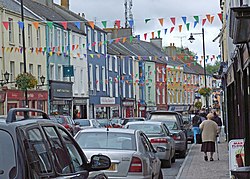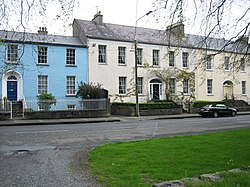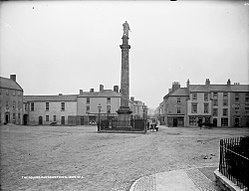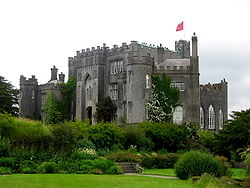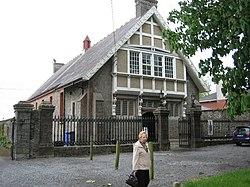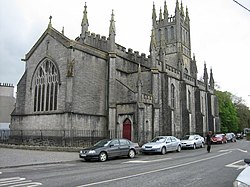Birr
| Birr Gaelic: Biorra | |
| County Offaly | |
|---|---|
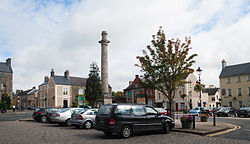 Emmet Square, Birr | |
| Location | |
| Grid reference: | N058045 |
| Location: | 53°5’29"N, 7°54’48"W |
| Data | |
| Population: | 5,818 (2011) |
| Post town: | Birr |
| Postcode: | R42 |
| Local Government | |
| Dáil constituency: |
Offaly |
Birr is a town in County Offaly. It was formerly called Parsonstown, after the Parsons family who were local landowners and hereditary Earls of Rosse, and renamed in 1899.[1] The name is from the Irish Biorra, meaning "plain of water". The town lies within a parish of the same name in the Roman Catholic Diocese of Killaloe.
Birr is a designated Irish Heritage Town with a carefully preserved Georgian heritage. Birr itself has graceful wide streets and elegant buildings. Many of the houses in John's Place and Oxmantown Mall have exquisite fanlight windows of the Georgian period.
The town is known for Birr Castle and its gardens, home of the Parsons family and also the Leviathan of Parsonstown which was the largest telescope in the world for over 70 years.
Contents
Access and transport
The town is situated at the meeting of the Camcor and Little Brosna rivers which flow on into the River Shannon near Victoria Lock.[2]
Birr railway station opened on 8 March 1858, but finally closed on 1 January 1963.[3]
The Ormond Flying Club has been in operation at Birr Airfield for over 30 years.[4] The area has been linked with aviation for some time – as a British Army airstrip was previously near the current field.
Birr lies on the N52 and N62 national secondary roads. The routes are combined as they pass through Birr. The R439, R440 and R489 regional roads also terminate in the town.
History
Ancient history
A monastery was founded here by St Brendan of Birr. It produced the MacRegol Gospels,[5] named after the abbot at the turn of the 8th/9th century and now to be seen in the Bodleian Library in Oxford. The Synod of Birr, held in 697, was the occasion on which the Cáin Adomnáin, or law of innocents, was pronounced.
In Gaelic Ireland, Birr was located in the O'Carroll territory of Éile. This petty kingdom formed an area that now forms the south of County Offaly and the north-east of County Tipperary. The tuatha was subject to the overkingdom of Munster and formed a border with the Kingdom of Meath to the east. The boundary between Ely O'Carroll and the ancient Meath is co-terminous with the present boundary between the Diocese of Killaloe and the Diocese of Meath. The O'Carroll family had a castle located at the present site of Birr Castle. Following the Plantations of Ireland, Birr was located in the Barony of Ballybritt following the formation of King's County in 1556.
The town itself is an old market and former garrison town dating to the 1620s.
Crotty Schism
The town was also the location of the Crotty Schism, one of the few schisms to affect the Catholic Church in Ireland in the 19th century. The ruins of a church on Castle Street was the result of the Crotty Schism however it is now in a derelict condition after it fell into disuse following the end of the schism. The church is known locally as Crotty's Church. In recent years it has become a hub for social dancing.
Crinkill barracks
Crinkill Barracks became the depot of the Prince of Wales's Leinster Regiment (Royal Canadians) from 1881. The barracks at Birr was burned down in 1922 during the Irish Civil War and the outer perimeter wall is all that remains.
Annalistic references
See Annals of Inisfallen.
- AI664.1 Kl. Death of Cúcen Máthair, and of Diarmait, son of Aed Slaine. [AU 665]. Fighting in Birra.
- AI822.1 Kl. Mac Riaguil, abbot of Birra, rested.
Features
Georgian Birr
Birr is a designated Irish Heritage Town due to the preservation and wealth of Georgian architecture in the town.[6] The earliest Georgian style buildings dating from 1740s are located in Emmet Square and Emmet street (then known as Cumberland Square and Cumberland Street).[7] The column in the centre of the square dates from 1747 and was built to carry the statue of the Duke of Cumberland, known as the Bloody Duke and the victor of the Battle of Culloden. The statue was removed in 1915 as it was in danger of collapse. The Oxmantown Mall was laid out in the early 19th Century and was designed as a promenade leading from Birr Castle gates to the Church of Ireland. The mall is tree lined on one side with the Georgian houses on the other.[7] John's Mall was also built during this time also with fine Georgian buildings.[7] The area is also known as the chains due to the sturdy chain railings enclosing the central plots in the centre of the Mall. Birr Town Council meets here in a building known as John's Hall built in the style of a Greek Temple.[7]
The Seffin Stone is said to mark the centre of Ireland.[7] Mentioned by Geraldus Cambrensis, who referred to it as Umbilicus Hiberniae, the indentations on the stone are as old as megalithic sites, such as Newgrange. Myths claim that the indentations are from the hand of Finn MacCool, hence the origin of the name as Suigh Finn (pronounced "See-Finn"), the Seat of Finn. It is located to the left of the gates to St John's Hall, on John's Mall, close to Emmet Square.
In Emmet Square stands Dooly's Hotel: one of the oldest coaching inns in Ireland, dating from 1747. The name of Galway Blazers was given to the Galway Hunt after a celebration held in the hotel in 1809 resulted in the premises being set on fire. Film director John Huston was latterly a member of the Galway Blazers. Australian soprano Dame Nellie Melba famously sang to crowds gathered below in the Square, from her hotel room above in Dooly's Hotel. The nightclub attached to the hotel is named "Melba's" to mark the occasion.
Ecclesiastical architecture
On the Wilmer road, near the County Arms Hotel is the beautiful Gothic-style Catholic church of 1817–25. St. Brendan's Church of Ireland was also built in Gothic style in 1815 and is located in the Oxmantown Mall. A smaller Methodist Church known as Wesley Chapel was built in 1820 on Emmett Street to accommodate a growing Methodist congregation following the preaching of John Wesley in the late 18th century in Birr.
The Sisters of Mercy convent on Wilmer road beside the Catholic church is also a gothic styled building. Most of the convent was converted by Offaly County Council to civic offices and a public library.
Birr Castle
Birr Castle is the oldest inhabited home in the county. In the 16th century the O'Carrolls of Éile had one of their castles here and this was granted to a Sir Laurence Parsons in the course of the Stuart plantation, c. 1620. Sir Laurence Parsons built most of the structure of the present castle. The castle was twice besieged in the 17th century and one of the towers still shows the scars of the artillery of Patrick Sarsfield, 1st Earl of Lucan, who tried unsuccessfully to take it. The castle remains the seat of the Earls of Rosse and is home to the current peer, Brendan, 7th Earl of Rosse, at present. As a family home, the Castle is only open to the public on special occasions. The surrounding demesne, however, is open to tourists every day of the year, and the gardens contain many fine trees and shrubs set in a landscaped park with waterfalls, river and lake.
In 1960, renowned photographer Antony, 1st Earl of Snowdon, took his new bride, Princess Margaret, to meet his mother, Anne, who was resident in Birr Castle. Anne, Countess of Rosse, was the wife of the|6th Earl.
Birr Telescope – The 'Leviathan of Parsonstown'
A main feature on the grounds of the castle is the great Leviathan of Parsonstown, an astronomical telescope with a 72-inch metal mirror erected by The 3rd Earl of Rosse, which was, until 1917, the largest telescope in the world.[8] The spiral structure of nebulae was discovered through this telescope. It featured in the PBS documentary, 'Telescope – Hunting the Edge of Space Part 1: The Mystery of the Milky Way' (2011). Astronomy broadcaster Sir Patrick Moore wrote The Astronomy of Birr Castle (1971), a history of the telescope and the significance of the work carried out here.
The workhouse
The workhouse, located in Syngefield, on Newbridge Street, opened in 1842[9] before the Great Famine. The building is now mainly derelict. It is not yet open to the public.
Birr Court House
Birr Court House, built c1830, is a detached five-bay two-storey castellated court house located on Townsend St, Birr. Over the years the building has served as a prison, court and county council offices.
Services and amenities
Birr is the principal market town of South Offaly and also for parts of north east Tipperary. The main street is lined with a wide variety of shops to cater for all needs. Within the town there are a number of educational facilities including 3 primary schools: St Brendan's Boys school, Mercy Primary School & the Model Primary School (Church of Ireland). There is one secondary school, St Brendan's Community School. Hotels include the County Arms and Dooly's Hotel. The newspaper The Midland Tribune'covering South Offaly and North Tipperary has its office in the town.
Sport
Hurling
Birr has a very successful hurling team, Birr GAA, winning the all-Ireland championship four times. Many of Birr's hurlers—including Brian Whelahan—learned their craft at St Brendan's Community School, which also boasts a strong musical and scientific tradition.
First All-Ireland Hurling Final and lowest score recorded
The first ever All-Ireland hurling final was played in Hoare's field (currently the location of a Tesco store) in Birr on Easter Sunday, 1 April 1888, between Tipperary and Galway. The match was won by Tipperary on a score line of 1 goal, 1 point and 1 forfeit point to Galway's no score. A forfeit point was given against a player carrying the sliotar over his own goal line.
The remarkably low score, albeit under different rules to the modern game, is recorded as the lowest score ever in a hurling match in the Guinness Book of Records.
Rugby
Founded in 1887 Birr RFC is one of the oldest rugby football clubs in Ireland. The club has lapsed on several occasions, particularly during the two world wars and again in the mid fifties. It was reformed in 1963 and has been in continuous existence since.[10]
Events and festivals
- The annual Birr Vintage Week and Arts Festival takes place in the town in August. The festival includes a variety of events over the week long period including the vintage parade, period markets, music & theatre.
- The Irish Hot Air Balloon Festival takes place in September from the grounds at Birr Castle.
- The Irish Game and Country Fair takes place in Birr Castle at the end of August and provides a huge range of entertaining and educational activities, displays and attractions over the weekend.
- Birr Theatre and Arts Centre located in the Oxmantown Mall is an important cultural & social amenity for the arts, dance, film music & theatre in the town. The theatre has a 220 seating capacity.[11] The building dates from January 1889 and is a fine and imposing Victorian period style structure within the pleasant surrounds of the tree lined Oxmantown Mall.[12] To date, many diverse productions have been staged at the theatre. Musicians Luka Bloom, Mundy, Jack L, Don Baker, Johnny Carroll, Frances Black, Ronnie Drew, Comedians Pat Short, Kevin McAlleer, The Drawing Room Opera Company, Co-Opera, Lamberts Puppet Theatre, Ballet Ireland and many local and national Theatre groups. Birr Stage Guild also have regular plays in the theatre.[13]
Recent developments and other facts
- On 31 August 1869, the first road fatality recorded in history occurred in Birr, when local born scientist Mary Ward, a cousin of The 3rd Earl of Rosse, fell from a steam-powered car on a bend. Unfortunately, the vehicle traversed her, causing the fatal injuries.
- A Grow-it-yourself[14] group set up in Birr in 2011 to inspire and assist local people to grow their own food.
- Since 2010 Birr's parks have seen considerable enhancements. The Mill Race running through the Mill Island Park was refurbished and water again flows through this watercourse. In 2011 the local council refurbished the walkways through the park and created extensions to the parks. A continuous walkway now stretches along the Camcor River from near Birr Castle down to close to Birr Workhouse.
- A descendant of the O'Carrolls, Charles Carroll was the only Catholic to sign the United States Declaration of Independence and, also, the only signatory to give his address. Signing such a potentially treasonous document was leaving oneself open to a death sentence. To distinguish himself from his father, Charles Carroll of Annapolis, he signed in full as "Charles Carroll of Carrollton". The first US Senator for Maryland, he is mentioned in the State song and a former home forms part of Johns Hopkins University.
- The gardens in Birr Castle feature the tallest box hedges in the world.
People
- John Caffrey, recipient of the Victoria Cross
- Joseph Stirling Coyne (1803–1868), playwright, journalist, and one of the first editors of Punch magazine.
- Barry Glendenning, journalist
- Mundy, musician
- Roesy, musician
- John Murray, recipient of the Victoria Cross
- Brian Whelahan, hurler
- Johnny Pilkington, hurler
- Aidan Quinn, actor
- The 3rd Earl of Rosse, astronomer
- The 7th Earl of Rosse, businessman and owner of Birr Castle
- Luka Bloom, singer, wrote most of his 1998 album 'Salty Heaven' while resident in the town and described Birr as having the best trees in Ireland in the album's liner notes.
- George Johnstone Stoney, physicist
- Des Keogh, actor, born in Birr in 1935
- Michael McAteer, scholar
- William Bulfin, early 20th Century author
- Eamon Bulfin, Irish republican activist during the Easter 1916 rising, raised the Irish Tricolour over the GPO during the rising.
References
- ↑ "Registration Districts of Ireland". genealogyresearch.org.uk. p. 31. http://genealogyresearch.org.uk/IRL_RegistrationDistricts1871.pdf. Retrieved 9 February 2013.
- ↑ http://www.shannonrbd.com/Final%20RBMP/Little%20Brosna%20WMU.pdf
- ↑ "Birr station". Railscot – Irish Railways. http://www.railscot.co.uk/Ireland/Irish_railways.pdf. Retrieved 12 September 2007.
- ↑ Ormand Flying Club
- ↑ The Gospel Book of Macregol of Birr. Birrhistsoc.com (3 September 2006).
- ↑ Birr, Offaly, Ireland – Heritage Town. Heritagetowns.com.
- ↑ 7.0 7.1 7.2 7.3 7.4 Birr History. Birrhistsoc.com.
- ↑ Greenslade Jr., Thomas B.. "The Earl of Rosse's Leviathan Telescope". Kenyon College. http://bulletin.kenyon.edu/x1446.xml.
- ↑ Birr Workhouse. Birrhistsoc.com (7 September 2013).
- ↑ "http://www.pitchero.com". Archived from the original on 20 February 2015. https://web.archive.org/web/20150220171630/http://www.pitchero.com/clubs/birrrugbyfootballclub/a/history-9413.html. Retrieved 2014-02-20.
- ↑ Birr Theatre and Arts Centre. Birrtheatre.com.
- ↑ Birr Theatre and Arts Centre. Birrtheatre.com.
- ↑ [1]
- ↑ GIY International – Together We Grow!. Giyireland.com.
Outside links
| ("Wikimedia Commons" has material about Birr) |
- Birr Theatre & Arts Centre
- Birr Leisure Centre
- The Birr Scientific and Heritage Foundation (link 1)
- The Birr Scientific and Heritage Foundation (link 2)
- Birr Castle Demesne
- Birr Town Council
- Dan Heller's (recent) images of Birr Castle and gardens
- Ely O'Carroll country
- Birr Photography Group
- Birr GAA Club
